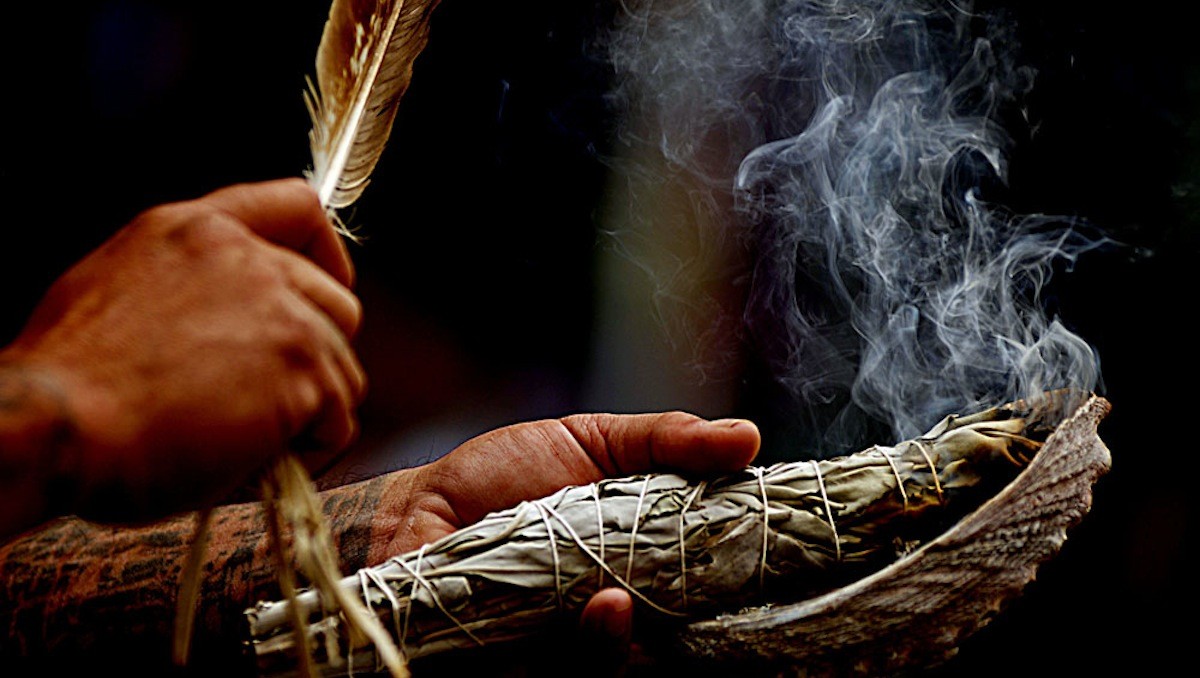
Whispers of Smoke: The Profound Significance of Sage in Native American Cleansing
The air grows still, pregnant with anticipation. A small bundle of dried leaves, tied with natural twine, is carefully ignited. A wisp of smoke, thin and ethereal at first, begins to unfurl, carrying with it an ancient wisdom, a promise of purification. This is the act of smudging, and at its heart lies sage, a plant revered and indispensable in the spiritual practices of countless Native American tribes for millennia. Far more than a simple act of burning herbs, smudging with sage is a profound ritual of cleansing, healing, and spiritual connection, deeply interwoven with the very fabric of Indigenous cultures.
To understand the significance of sage, one must first understand the worldview it inhabits. For Native American peoples, the natural world is not merely a resource but a living relative, imbued with spirit and intelligence. Plants are teachers, healers, and conduits to the spiritual realm. Sage, particularly White Sage (Salvia apiana), stands as one of the most powerful and respected of these plant allies. Its use transcends tribal boundaries, though specific protocols and accompanying herbs may vary, reflecting the rich diversity of Indigenous nations across Turtle Island (North America).

An Ancient Practice, A Timeless Purpose
The roots of smudging with sage stretch back thousands of years, predating colonial contact. Archaeological evidence and oral traditions confirm its continuous presence in spiritual life. For many tribes, the practice is a daily act of spiritual hygiene, as essential as bathing for physical cleanliness. It is performed to cleanse oneself, others, ceremonial tools, sacred spaces, and even homes or objects, ridding them of negative energies, thoughts, or spirits.
"Smudging is about purification, about clearing the path," explains a respected Elder from the Lakota tradition (name withheld for privacy, a common practice in journalistic portrayals of sensitive Indigenous knowledge). "When we smudge, we are inviting the good spirits, the ancestors, to be with us, and we are asking the smoke to carry away what no longer serves us – fear, anger, illness, confusion. It’s a way to prepare ourselves, our minds, our hearts, for prayer or for healing."
The process itself is a deeply intentional and sacred act. Typically, dried sage is bundled into a "smudge stick" or used as loose leaves. It is lit, often with a match or lighter, and then the flame is gently fanned out, allowing the sage to smolder and produce smoke. This smoke is then directed using a feather, a hand, or a shell, usually an abalone shell. Each component holds symbolic meaning:
- Sage (Earth): Represents the plant kingdom, the grounding energy of the earth.
- Abalone Shell (Water): Symbolizes the ocean, the element of water, and the vastness of creation.
- Feather (Air): Represents the winged ones, the element of air, and the breath of life.
- Fire: The transformative element, the spark of creation, which releases the sage’s spiritual properties.

Together, these four elements – earth, water, air, and fire – create a holistic representation of the natural world, emphasizing the interconnectedness of all things. As the smoke rises, prayers and intentions are often offered, transforming the physical act into a profound spiritual dialogue.
Spiritual Armor and Emotional Release
The primary significance of sage in cleansing lies in its spiritual properties. Indigenous belief systems hold that negative energies can cling to individuals, spaces, or objects, causing imbalance, illness, or discord. Sage smoke is believed to have the power to "wash away" these impurities. It acts as a spiritual disinfectant, purifying the aura, thoughts, and emotions.
Beyond simply removing the negative, sage also invites the positive. After cleansing, the space or individual is left open and receptive to positive energy, clarity, peace, and spiritual guidance. This dual action makes it invaluable for:
- Preparing for Ceremony: Smudging often precedes pow-wows, healing ceremonies, council meetings, or sacred rituals, ensuring participants and the space are in a state of purity and reverence.
- Healing: It is used in traditional healing practices to clear spiritual blockages, aid in emotional release, and support physical recovery by creating a conducive environment for healing.
- Grief and Loss: Smudging can help individuals process grief, releasing sorrow and inviting comfort during times of mourning.
- New Beginnings: It is used to bless new homes, cars, or significant life transitions, clearing old energies and inviting positive ones.
While the primary benefits are spiritual and energetic, modern science has also noted some fascinating properties of sage. Studies have shown that burning certain herbs, including sage, can reduce airborne bacteria. However, it is crucial to emphasize that for Native Americans, the spiritual efficacy of sage far outweighs any scientific explanation. Its power comes from the Creator, from the spirit of the plant itself, and from the deep reverence and intention with which it is used.
Beyond White Sage: A Symphony of Sacred Plants
While White Sage (Salvia apiana) is perhaps the most widely recognized for smudging, it is important to note that many tribes utilize other sacred plants for similar purposes, each with its unique spiritual properties:
- Cedar (Thuja occidentalis): Often used for protection and to draw in positive energy. Its strong, woody scent is grounding and fortifying.
- Sweetgrass (Hierochloe odorata): Braided into long ropes, sweetgrass is burned after sage or cedar to invite in good spirits, positive energy, and bring blessings. It is known for its sweet, vanilla-like fragrance, symbolizing kindness, healing, and peace.
- Tobacco (Nicotiana rustica/tabacum): A highly sacred plant in many traditions, tobacco is often offered as a prayer or an offering to the Creator or ancestors, rarely burned for cleansing in the same way as sage. It serves as a powerful medium for communication between worlds.
The specific choice of plant often depends on tribal traditions, regional availability, and the particular intention of the smudging ceremony. This diversity underscores the rich tapestry of Indigenous spiritual practices.
Resilience, Reclamation, and the Shadow of Appropriation
In an era marked by cultural resurgence, the practice of smudging with sage has seen a renewed embrace among Native American youth and communities. After centuries of colonial suppression, including outright bans on traditional ceremonies (such as the American Indian Religious Freedom Act of 1978, which finally lifted federal restrictions on Native American religious practices), the act of smudging stands as a powerful symbol of resilience, cultural pride, and decolonization. It is a way to reconnect with ancestral wisdom, maintain spiritual well-being, and affirm identity in a world that often seeks to erase it.
However, the growing popularity of smudging, particularly with white sage, has also led to significant challenges, most notably cultural appropriation and unsustainable harvesting. As smudging has been decontextualized and commercialized by non-Indigenous businesses and individuals, white sage has become a trendy item sold in metaphysical shops, online stores, and even major retail chains. This commodification strips the practice of its sacred meaning, reducing it to a mere commodity or a New Age fad.
This appropriation is harmful on multiple levels:
- Disrespect and Decontextualization: It ignores the deep spiritual significance, the historical trauma associated with its suppression, and the specific cultural protocols surrounding its use.
- Environmental Impact: The soaring demand has led to widespread overharvesting and poaching of wild white sage, particularly in its native habitats in Southern California and Baja California. This threatens the plant’s populations and makes it harder for Indigenous communities, who have historically stewarded these lands, to access their sacred medicine.
- Economic Disparity: Non-Indigenous businesses profit immensely from a practice that originated from and belongs to Indigenous peoples, often without acknowledging or supporting the communities from which it comes.
As Indigenous leaders and environmentalists emphasize, it is crucial for non-Indigenous people to approach the use of sage, and all Indigenous spiritual practices, with profound respect and caution. Many recommend that non-Indigenous individuals refrain from using white sage for smudging unless they have been explicitly taught by an Indigenous elder or are participating in a ceremony led by Indigenous people. Instead, they suggest exploring their own ancestral spiritual traditions or seeking alternative, non-Indigenous cleansing practices.
For those who wish to support Indigenous communities and engage respectfully, the advice is clear:
- Educate Yourself: Learn about the specific traditions and protocols of the tribes in your region.
- Seek Permission/Guidance: If you are non-Indigenous and wish to learn about or participate in Indigenous practices, seek direct guidance from Indigenous elders or cultural teachers.
- Support Indigenous Businesses: If purchasing sage or other ceremonial items, prioritize Indigenous-owned businesses that harvest sustainably and respectfully.
- Consider Alternatives: If you are non-Indigenous and seeking a cleansing practice, explore herbs native to your own ancestral lands or practices from your own cultural heritage.
A Living Prayer
The significance of sage in Native American cleansing is profound and multifaceted. It is a sacred tool for spiritual purification, emotional release, and a vital connection to the spirit world. It represents the enduring wisdom of Indigenous peoples, their deep reverence for the Earth, and their unbreakable bond with their ancestors.
As the smoke of sage continues to rise, it carries with it not just prayers for purification, but also the enduring spirit of resilience, the call for respect, and the hope for a future where Indigenous traditions are understood, honored, and protected for generations to come. It is a reminder that some of the most powerful medicines are not found in bottles, but in the whispers of smoke from a sacred plant, nurtured by centuries of wisdom and reverence.


